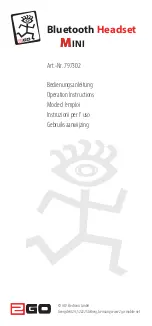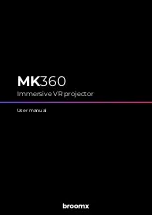
10
with waterless hand cleaners or products containing lanolin.
• Do not store the earmuff in temperatures above 131º F
(+55 ºC), for example behind a windshield or window.
• Inspect earmuffs regularly for cracked or worn parts,
especially the cushions. Replace as needed. For replacement
foam liners and ear cushions, order Hygiene Kit HY79. 3M
recommends replacing foam liners and cushions at least
twice a year in order to maintain acceptable noise reduction,
hygiene and comfort.
6. FCC AND IC REGULATIONS AND WARNINGS
6.1. FCC Warning
This device complies with part 15 of the FCC Rules. Opera-
tion is subject to the following two conditions:
(1) This device may not cause harmful interference, and
(2) this device must accept any interference received,
including interference that may cause undesired operation.
Any Changes or modifications not expressly approved by
the party responsible for compliance could void the user’s
authority to operate the equipment. Before any station
transmits on any channel authorized in the GMRS from an
point (a geographical location) within or over the territorial
limits of any area where radio servicesare regulated by the
FCC, the responsible party must obtain a license (a written
authorization from the FCC for a GMRS system).
6.2 FCC Radiation Exposure Statement
This equipment complies with FCC radiation exposure limits
set forth for an uncontrolled environment. This transmitter
must not be co-located or operating in conjunction with any
other antenna or transmitter. Do not transmit for more than
50% of the total transceiver use time; transmitting over 50%
of the total use time may exceed the limits in accordance to
the FCC RF exposure requirements. Nominal transceiver
operation is 5% transmission time, 5% reception time and
90% stand-by time.
6.3 IC Warning
This device complies with Industry Canada license-exempt
RSS standard(s). Operation is subject to the following
two conditions:
(1)This device may not cause interference and
(2) this device must accept any interference, including interfe-
rence that may cause undesired operation of the device.
Under Industry Canada regulations, this radio transmitter
may only operate using an antenna of a type and maximum
(or lesser) gain approved for the transmitter by Industry
Canada. To reduce potential radio interference to other users,
the antenna
type and its gain should be so chosen that, the equivalent
isotropically radiated power (e.i.r.p.) is not more than that
necessary for successful communication.
7. ATTENUATION (table K)
The NRR calculated from these laboratory-based attenuation
data is 25 in the over the head and hard hat attached
versions and 26 when worn behind the head.
The NRRs may overestimate the hearing protection provided
during typical use due to variation in earmuff fit, earmuff fitting
skill and motivation of the user. 3M recommends reducing
the NRR by 50% for estimating the amount of noise reuction
provided.
The level of noise entering a person’s ear. when a hearing
protector is worn as directed, is closely approximated by the
difference between the A-weighted environmental noise level
and the NRR.
Example:
1. The environmental noise level as measured at the ear is
92 dB(A).
2. The NRR is 25 decibels (dB).
3. The level of noise entering the ear is approximately equal
to 67 dB(A).
Caution! For noise environments dominated by
frequencies below 500 Hz, the C-weighted environmental
noise level should be used. Although hearing protectors
can be recommended for protection against the harmful
effects of impulsive noise, the noise reduction rating
(NRR) is based on the attenuation of continuous noise
and may not be an accurate indicator of the protection
attainable against impulsive noise such as gunfire.
Improper fit of this device will reduce its effectiveness
in attenuating noise. Consult the fitting instructions for
proper fit.
Caution!
When set to full gain the earphones can produce
an equivalent sound level of up to 87dB(A). This is conside-
red safe for daily 8-hours use, as long as the time spent in
receiving mode does not exceed 2.5 hours. If the time spent
listening to the earphones exceeds 2.5 hours per day the
gain setting must be reduced below maximum. One step
below maximum gain produces an equivalent sound level of
82 dB(A), considered safe even if used in the listen mode, in
noise, for a full 8-hours day.
If after wearing this device, tinnitus (ringing or buzzing in the
ears) is heard, or your hearing seems muffled or dulled, or for
any other reason you suspect a hearing problem, the volume
levels should be reduced and the fit, condition, and adequacy
of this device should be checked for the noise in which it is
being worn. If the condition persists see an audiologist or phy-
sician for a professional review.
8. SPARE PARTS/ACCESSORIES
3M™ PELTOR™ HY79 Hygiene kit
Replaceable hygiene kit consisting of two attenuation cushi-
ons, two foam rings and two snap-in ear cushions. Replace
at least twice a year to ensure constant attenuation, hygiene
and comfort.
3M™ PELTOR™ HY100A Single-use protectors
A single-use protector that is easy to fit to the ear cushions.
Pack of 100 pairs.
EN




































